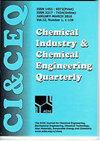纳米石墨烯悬浮乙二醇/水的热物性变化研究
IF 0.8
4区 工程技术
Q4 CHEMISTRY, APPLIED
Chemical Industry & Chemical Engineering Quarterly
Pub Date : 2021-01-01
DOI:10.2298/ciceq200504036p
引用次数: 1
摘要
本研究的目的是确定石墨烯悬浮基液(乙二醇(EG)/水(W))在石墨烯纳米颗粒浓度和热流体入口温度方面的热物理性质变化(如粘度、密度、比热容和导热系数)。初始制备石墨烯纳米颗粒浓度(0.2、0.4、0.6、0.8和1 vol.%)和30:70 vol.% EG: Water的基础液。在工业板式换热器实验的基础上,研究了纳米石墨烯对基液的影响。实验中,热流体入口温度分别为55℃、65℃和75℃。将热物理性质的实验结果与文献中提出的模型进行了比较。Einstein(1956)、Kitano(1981)和Bachelor(1977)模型被用来考虑粘度的影响。测定的密度和比热容分别用Pak、Cho和Xuan模型进行验证。为了考虑热导率的影响,使用了三种不同的模型(Maxwell (1954), Vajjah(2010)和Sahoo(2012))。研究表明,基液的热物理性质对石墨烯纳米颗粒悬浮液有显著影响。本文章由计算机程序翻译,如有差异,请以英文原文为准。
Studies on thermophysical property variations of graphene nanoparticle suspended ethylene glycol/water
The objective of the study is to determine the thermophysical property variations (such as viscosity, density, specific heat capacity and thermal conductivity) of graphene suspended base fluid (ethylene glycol (EG)/water (W)), with respect to graphene nanoparticle concentration and hot fluid inlet temperature. Graphene nanoparticle concentrations (0.2, 0.4, 0.6, 0.8 and 1 vol.%) and the base fluid of 30:70 vol.% of EG: Water is prepared initially. The impact of graphene nanoparticle addition on base fluids based on experimentation in the commercial plate heat exchanger was studied. In this experiment, the hot fluid inlet temperature was varied at 55, 65 and 75 ?C. The experimental results of thermophysical properties were compared with the selected models proposed in the literature. Einstein (1956), Kitano (1981) and Bachelor models (1977) have been used to consider the effect of viscosity. The measured density and specific heat capacity were validated with Pak and Cho and Xuan models, respectively. To consider the effect of thermal conductivity, three different models (Maxwell (1954), Vajjah (2010) and Sahoo (2012)) have been used. Study revealed that the thermophysical properties of base fluid significantly affect the graphene nanoparticle suspension.
求助全文
通过发布文献求助,成功后即可免费获取论文全文。
去求助
来源期刊

Chemical Industry & Chemical Engineering Quarterly
CHEMISTRY, APPLIED-ENGINEERING, CHEMICAL
CiteScore
2.10
自引率
0.00%
发文量
24
审稿时长
3.3 months
期刊介绍:
The Journal invites contributions to the following two main areas:
• Applied Chemistry dealing with the application of basic chemical sciences to industry
• Chemical Engineering dealing with the chemical and biochemical conversion of raw materials into different products as well as the design and operation of plants and equipment.
The Journal welcomes contributions focused on:
Chemical and Biochemical Engineering [...]
Process Systems Engineering[...]
Environmental Chemical and Process Engineering[...]
Materials Synthesis and Processing[...]
Food and Bioproducts Processing[...]
Process Technology[...]
 求助内容:
求助内容: 应助结果提醒方式:
应助结果提醒方式:


